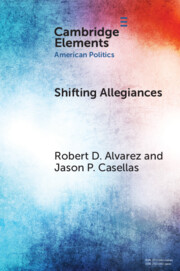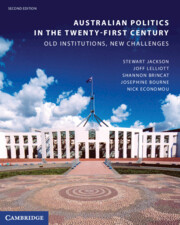Refine search
Actions for selected content:
31 results
11 - Law-Making and Incentive Bargaining
- from Part V - Legislative Policies
-
- Book:
- Incentive Bargaining and Corporate Governance
- Published online:
- 12 December 2025
- Print publication:
- 08 January 2026, pp 321-346
-
- Chapter
- Export citation
Legislative Cooptation in Authoritarian Regimes: Policy Cooperation in the Kuwait National Assembly
-
- Journal:
- British Journal of Political Science / Volume 55 / 2025
- Published online by Cambridge University Press:
- 14 May 2025, e72
-
- Article
-
- You have access
- Open access
- HTML
- Export citation
45 - Legislatures
- from Part III. C - The Democratic System
-
-
- Book:
- The Cambridge Handbook of Constitutional Theory
- Published online:
- 27 March 2025
- Print publication:
- 24 April 2025, pp 792-809
-
- Chapter
- Export citation

Shifting Allegiances
- The Election of Latino Republicans to Congress and State Legislatures
-
- Published online:
- 21 April 2025
- Print publication:
- 22 May 2025
-
- Element
- Export citation
3 - Why Are Some States More Corrupt than Others?
- from Part I - How Corrupt Is America?
-
- Book:
- Corruption in America
- Published online:
- 21 March 2025
- Print publication:
- 03 April 2025, pp 33-54
-
- Chapter
- Export citation
2 - Can We Measure Corruption?
- from Part I - How Corrupt Is America?
-
- Book:
- Corruption in America
- Published online:
- 21 March 2025
- Print publication:
- 03 April 2025, pp 18-32
-
- Chapter
- Export citation
Measuring legislators’ ideological position in large chambers using pairwise-comparisons
-
- Journal:
- Political Science Research and Methods , First View
- Published online by Cambridge University Press:
- 23 January 2025, pp. 1-18
-
- Article
-
- You have access
- Open access
- HTML
- Export citation
Democracy and the Notwithstanding Clause
-
- Journal:
- Canadian Journal of Law & Jurisprudence / Volume 37 / Issue 2 / August 2024
- Published online by Cambridge University Press:
- 30 May 2024, pp. 545-570
-
- Article
-
- You have access
- Open access
- HTML
- Export citation
Explaining Activity in Authoritarian Assemblies: Evidence from China
-
- Journal:
- Journal of East Asian Studies / Volume 22 / Issue 3 / November 2022
- Published online by Cambridge University Press:
- 17 October 2022, pp. 435-455
-
- Article
-
- You have access
- Open access
- HTML
- Export citation

Australian Politics in the Twenty-First Century
- Old Institutions, New Challenges
-
- Published online:
- 06 September 2022
- Print publication:
- 02 September 2022
-
- Textbook
- Export citation
Chapter 3 - The legislature: Representative democracy
-
- Book:
- Australian Politics in the Twenty-First Century
- Published online:
- 06 September 2022
- Print publication:
- 02 September 2022, pp 52-78
-
- Chapter
- Export citation
13 - Abortion
- from Part II - Concretion
-
- Book:
- Through Thin and Thick
- Published online:
- 18 June 2022
- Print publication:
- 30 June 2022, pp 104-119
-
- Chapter
- Export citation
1 - The Legal Nature of the Security Council
-
- Book:
- The UN Security Council and International Law
- Published online:
- 02 June 2022
- Print publication:
- 09 June 2022, pp 5-27
-
- Chapter
- Export citation
12 - ‘Only Time Will Tell’
-
-
- Book:
- Law and Legacy in Medical Jurisprudence
- Published online:
- 23 December 2021
- Print publication:
- 10 March 2022, pp 250-278
-
- Chapter
- Export citation
2 - The Institutional and Legal Context of Administrative Law
-
- Book:
- Contemporary French Administrative Law
- Published online:
- 24 February 2022
- Print publication:
- 03 March 2022, pp 26-60
-
- Chapter
-
- You have access
- Open access
- HTML
- Export citation
The legislature as political control: change and continuity in Cameroon's National Assembly (1973–2019)
-
- Journal:
- The Journal of Modern African Studies / Volume 59 / Issue 4 / December 2021
- Published online by Cambridge University Press:
- 01 December 2021, pp. 485-506
- Print publication:
- December 2021
-
- Article
- Export citation
11 - Brexit and the Problem with Delegated Legislation
- from Part II - Institutional Pressures and Contested Legitimacy
-
-
- Book:
- The Brexit Challenge for Ireland and the United Kingdom
- Published online:
- 17 August 2021
- Print publication:
- 26 August 2021, pp 239-259
-
- Chapter
- Export citation
5 - The Pan-African Parliament
- from Part II - The African Union
-
- Book:
- Contesting Sovereignty
- Published online:
- 30 June 2021
- Print publication:
- 22 July 2021, pp 133-162
-
- Chapter
- Export citation
4 - Signature
-
- Book:
- Committed to Rights
- Published online:
- 14 January 2021
- Print publication:
- 28 January 2021, pp 63-107
-
- Chapter
- Export citation
3 - The Political Origins of the Property Rights Gap
-
- Book:
- Property without Rights
- Published online:
- 22 December 2020
- Print publication:
- 07 January 2021, pp 71-123
-
- Chapter
- Export citation
